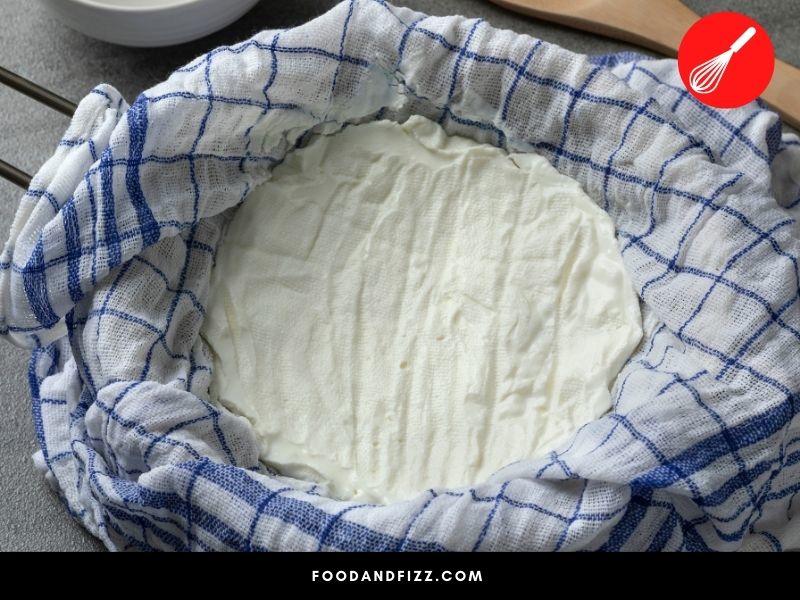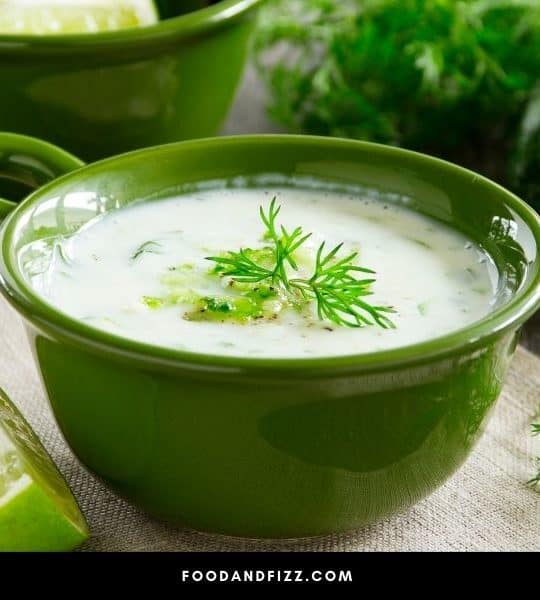Yogurt is a healthy snack that can be enjoyed on its own or can be added to both cold or hot dishes to give them an extra dose of flavor and texture. It can be used both in sweet recipes and in savory recipes and is an excellent base for a sauce.
There are many different types of yogurt, and consistency varies from brand to brand, and from home to home if you are making it on your own.
It also varies depending on the type of milk that was used, whether low fat or full fat, which can affect the consistency of the final product and consequently, the consistency of the dishes you use them in.
Luckily, a too-thin yogurt sauce isn’t the end of the world. Today, we’ll explore the 10 best ways to thicken yogurt sauce.
Best Ways to Thicken Yogurt Sauce
The best ways to thicken yogurt sauce are: using a cornstarch slurry, adding a mix of flour and water, thickening with a roux, adding a tapioca starch paste, adding xanthan gum or guar gum, using gelatin, adding a thicker type of yogurt, adding a thicker dairy product like cheese, straining the yogurt, cooking the sauce a little longer to reduce it or storing the yogurt sauce in the fridge to thicken it.

10 Best Ways to Thicken Yogurt Sauce
Yogurt indeed has many uses and is often easy to tweak depending on the needs of your recipe. In case it is too thick or too thin, there are things that can be done to fix the consistency to make the recipe form.
In cases where the sauce is too thick, it can be thinned easily by adding more liquid, which is a pretty straightforward step.
But what if your sauce is too thin? Is there anything you can do?
Here are the 10 best ways to thicken yogurt sauce.
1. Cornstarch Slurry
If you find that your yogurt sauce is too thin, you can make a cornstarch slurry by dissolving equal parts cornstarch and water, and then adding it to your sauce.
Starches are especially good at thickening sauces, especially heated sauces because of the specific action of starch molecules in the presence of water. They soak up the excess water in your liquid and “swell up”, causing your mixture to thicken.
For every cup of sauce, mix one tablespoon of cornstarch with one tablespoon of water and mix to dissolve.
You can increase the amount of cornstarch and water if you want a thicker sauce, but make sure not to add too much.
If you have added too much, you might still be able to fix it: Too Much Cornstarch – How Do You Fix It?
Cornstarch is also a nice gluten-free alternative to flour.

2. Flour and Water
To thicken a sauce using flour, combine two tablespoons of flour with ¼ cup of water and mix thoroughly, making sure there are no lumps.
Use this proportion for every cup of sauce you wish to thicken. Slowly add to your sauce over heat and mix to avoid any lumps.
3. Make a Roux
Another option to thicken a sauce is to make a roux. A roux is an equal mixture of flour and fat by weight. The most common fat used for a roux is butter, but you can use others such as olive oil.
The type of fat you use will depend of course on the recipe you are making. Some would work better than others but as long as you stick to the right proportions, it should work fine.
To make a roux, simply heat butter (or another fat) in a saucepan. It is hot enough if when you sprinkle flour over it, the butter bubbles.
Add the rest of the flour and mix to make a paste. Cook the roux until golden brown and add to your sauce to thicken.
3. Tapioca Starch
If you are sensitive to gluten and have issues with corn, you can choose to use tapioca starch to make a slurry to thicken your yogurt sauce. A starch derived from cassava root, tapioca starch is a good substitute for cornstarch in recipes.
However, you need twice as much tapioca as you would cornstarch so to thicken a cup of sauce, you need two tablespoons of tapioca starch dissolved in two tablespoons of water.
Tapioca starch also clumps easily and becomes stringy when overheated, so it is best to keep watch over your sauce as it thickens.
4. Xanthan Gum or Guar Gum
If you’ve ever explored gluten-free baking, you’ll be familiar with xanthan gum and guar gum. Both are plant-derived thickeners, stabilizers, and emulsifiers that are used primarily to help gluten-free baked goods achieve and maintain their structure.
Unlike cornstarch and the other starches, they do not need heat to activate their thickening powers, and when sprinkled into your sauce, will thicken it pretty much instantly. It is more potent than flour or cornstarch as you would only need a fraction of it to work its powers.
For every cup of sauce, you only need a little bit of xanthan gum (a pinch is good!). Simply sprinkle on your sauce and mix thoroughly. It will thicken instantly. For guar gum, experts recommend using about ¼ teaspoon for every cup of liquid.
5. Gelatin or Agar-agar
When used properly, gelatin can be an effective thickener. For use in warm sauces, “bloom” one packet of powdered gelatin in ¼ cup of cold water and let sit for about 5 minutes to hydrate. Add to warm sauce and stir to properly dissolve.
Gelatin can also be used to thicken homemade yogurt. Simply let the packet of gelatin bloom in cold milk, and then heat to the proper temperatures. According to Cultures for Health, the gelatin must be heated to 95°F in order for it to work.
For a vegan and plant-based alternative to gelatin, agar-agar may be used. Agar-agar is used to thicken many plant-based yogurts. This is because gelatin is typically not vegetarian: “Is Porcine Gelatin Vegetarian?“

6. Add A Thicker Variety of Yogurt
If you don’t want to go the flour, starch, gum, or gelatin route, you may opt just to add more yogurt to your sauce, but this time, using a thicker variety.
Greek-style yogurt has a thicker consistency than regular, plain yogurt. Adding Greek yogurt to your sauce will help achieve a thicker consistency.
7. Add Cheese, Sour Cream, or Crème Fraiche
Especially for cold sauces and dips, and maybe salad dressing, adding other dairy products with a thicker consistency can help thicken your yogurt sauce.
Sour cream or crème Fraiche, as well as soft cheeses like cream cheese, ricotta, quark, or mascarpone, may complement your yogurt dip or yogurt sauce very well.
They may alter the taste of your sauce a little bit but that isn’t necessarily a bad thing.
8. Use a Cheesecloth and Strain Yogurt
If your yogurt is too watery, you may also opt to strain it to remove some of the water or excess whey. This essentially is like making Greek-style yogurt.
Placing your yogurt in cheesecloth and leaving it to strain for a few hours results in thicker yogurt that can readily be used for sauces.

9. Cook the Sauce a Little Longer or Store it in the Fridge
If you don’t want to add anything to your sauce, you may choose to cook it a little longer to naturally thicken it and reduce it. For cold sauces, you may also opt to store it in the fridge.
Yogurt usually thickens as it cools down so depending on the recipe, this may work to thicken your sauce as well.
There are many other things you can use to thicken your yogurt sauce, from the use of other types of flours and starches to mixing in some other ingredients to improve its consistency. But the options outlined above are easy ways to thicken it without significantly altering the flavor of your sauce.
What is Yogurt?
Yogurt is a dairy product produced from milk that’s been heated and fermented with bacterial cultures that produce lactic acid. Due to the presence of bacterial cultures, its consistency becomes thicker than the milk it started with, but depending on the fat content of the milk used, can have a range of consistency from light cream to cream cheese.
Greek-style yogurt is typically thicker than plain yogurt since an added step in its processing is straining the whey, or the liquid part of the milk, resulting in a thicker, more concentrated yogurt with the consistency of cheese.
Yogurt is high in protein and an excellent source of calcium and fat-soluble vitamin D. Because it is fermented, it contains healthy probiotics that are great for gut health and digestion.
Yogurt is typically made with cow’s milk but can be made with sheep’s milk, and goat’s milk, and can even be made with plant-based milk. With the rise of veganism, it is not uncommon to encounter soy yogurt or coconut yogurt in grocery stores.
Uses of Yogurt
Yogurt is awesome enjoyed on its own, especially when flavored, or topped with fresh or dried fruits, nuts, seeds, or mixed in with oatmeal or enjoyed in chia pudding.
It is a great base for salad dressings, a thickener for savory sauces, especially Indian or Thai curries, a replacement for crème Fraiche or sour cream in a dish like Beef Stroganoff, a healthier choice for dips and sides, and can even be used in place of cream on top of baked goods.
It can also be used as a milk or buttermilk replacement in cakes, muffins, and pies due to its acidity and ability to produce a tender, moist crumb. Yogurt can also be used to tenderize and marinate meats prior to cooking.
Below are some more other uses for yogurt:
- Tzatziki or Yogurt Dip
- Yogurt Popsicles
- Breakfast smoothies
- Panna Cotta
- Pancakes and waffles
- Yogurt Cakes
- Frozen Yogurt bark
- Meat marinade and sauce
- Biscuits and Flatbreads
Yogurt is perfectly versatile and healthy, too. No wonder it is a staple food in many different cultures.

Conclusion to 10 Best Ways to Thicken Yogurt Sauce
Too-thin yogurt is not the end of the world as there are many things you can do to thicken it and firm it up.
Through the use of flour, starches, gums, gelatin, and other dairy products like cheese, or through straining and cooking it longer, or storing it at lower temperatures, there are many possible things you can explore to save your yogurt sauce, and not have to start from scratch.
Frequently Asked Questions to 10 Best Ways to Thicken Yogurt Sauce
How Do I Thicken Yogurt with Cornstarch?
To thicken yogurt using cornstarch, heat yogurt in a saucepan. For every cup of yogurt, dissolve one tablespoon of cornstarch in one tablespoon of water, and add to the yogurt, mixing thoroughly until thickened.
How to Fix Watery Yogurt?
Watery yogurt can be strained using a cheesecloth to remove the excess water or whey that causes it to be watery, or you may add thickeners to it such as cornstarch to make it a thicker consistency.

